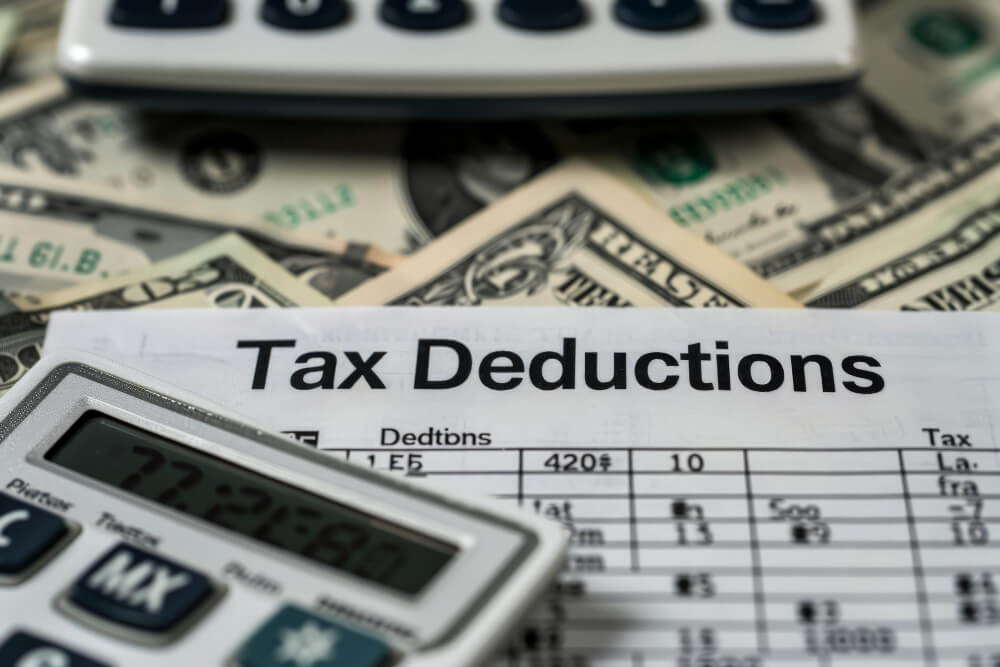A tax deduction is an expense that can be subtracted from taxable income, reducing the amount of income subject to tax. This results in a lower tax liability for individuals or businesses. Examples include deductions for mortgage interest, charitable donations, and business expenses.
As a small business owner, one of the tasks to prepare for tax season is to calculate your deductions and learn how to save more money.
What Is The Home Office Deduction?
The home office deduction allows eligible taxpayers to deduct expenses related to a home workspace used exclusively and regularly for business. This deduction covers a portion of rent, mortgage interest, utilities, repairs, and other household costs.
To qualify, the space must serve as the principal place of business or be used for meeting clients or customers. Here are two methods available for calculating this deduction: the simplified method, which offers a flat rate per square foot, and the regular method, which requires tracking actual expenses.
How Does The Home Office Tax Deduction Work?
The home office tax deduction reduces taxable income by accounting for business-related use of a home workspace. Only spaces used exclusively and regularly for business qualify.
Two calculation methods exist:
- Simplified Method – Multiply the workspace’s square footage by a set rate (currently $5 per square foot, up to 300 square feet).
- Regular Method – Calculate the percentage of the home used for business and apply that percentage to eligible expenses, such as rent, utilities, and maintenance.
Read more: How to File Self-Employed Taxes: The Complete Guide
How Do I Calculate The Home Office Tax Deduction?
To calculate the home office tax deduction, select either the simplified or the regular method, depending on your situation. Each method offers a distinct approach to estimating the eligible amount.
1. Simplified Method
This option provides a straightforward calculation, reducing record-keeping.
- Multiply the square footage of your dedicated office space by a flat rate of $5 per square foot, with a cap of 300 square feet.
- Maximum deduction: $1,500 (300 sq ft × $5).
Example:
A home office that measures 200 square feet would yield a deduction of $1,000 (200 sq ft × $5).
This method is ideal if you prefer simplicity or if your total business-use expenses are modest. It avoids the need to track individual expenses but may not provide the maximum deduction in cases with high household costs.
2. Regular Method
The regular method provides more precision by calculating the business-use percentage of your home and applying that percentage to specific expenses.
Step 1: Calculate Business-Use Percentage
- Divide the office’s square footage by your home’s total square footage.
- Example: If the office occupies 150 square feet and your home totals 1,500 square feet, the business-use percentage is 10% (150 ÷ 1,500).
Step 2: Apply the Business-Use Percentage to Eligible Expenses
Expenses that qualify include:
- Mortgage interest or rent
- Property taxes
- Homeowners Insurance
- Utilities (electricity, water, internet)
- Repairs and maintenance
Example Calculation:
If your total home expenses for the year are $24,000 and the business-use percentage is 10%, the deductible is $2,400 (10% of $24,000).
Step 3: Track Direct and Indirect Expenses
- Direct expenses: Costs related solely to the home office (e.g., office repairs). Deduct these in full.
- Indirect expenses: General household expenses (e.g., rent, utilities). Deduct these based on the business-use percentage.
Choosing the Right Method
- Simplified Method works well for small home offices and those who prefer more straightforward calculations.
- Regular Method may offer a larger deduction but requires careful tracking of expenses and space allocation.
Important Considerations
- The workspace must be your principal place, used exclusively and regularly for business. Occasional or mixed personal use disqualifies the space.
- Proper documentation and receipts are essential, especially when using the regular method, to support your deduction in case of an audit.
Both methods provide tax relief by reducing the amount of income subject to taxation, though the regular method offers more flexibility for high-expense households.
Home Office Deduction Requirements
Exclusive Use
The home office must be dedicated entirely to business activities. Any personal use, even occasional, disqualifies the space. Areas with mixed-use, such as a dining table or shared room, do not meet this requirement.
Regular Use
The workspace must consistently serve business purposes. Irregular or sporadic use does not meet the standards needed to claim the deduction.
Principal Place of Business
The home office must act as the primary location for conducting business tasks. Even if business activities occur outside the home, the space must remain the central hub for essential operations, including administrative work or client meetings. The home office can still qualify when other business locations exist if it plays a key operational role.
Self-Employment or Employee Use
Freelancers, contractors, and self-employed individuals typically qualify for the deduction. Employees, however, can only claim the deduction if their employer requires them to work from home. If the employer offers an alternative work location, the deduction becomes unavailable.
Type of Work Conducted
The home office must support activities directly related to the business. Administrative tasks, meeting clients, and designing products are qualifying activities. Storing inventory or product samples can also qualify, provided the space is used exclusively and consistently.
Documentation and Record-Keeping
Accurate documentation is essential to claim the deduction. Tracking expenses like rent, mortgage interest, utilities, and repairs ensures compliance, especially when using the regular calculation method. Measurements of the workspace and the total home size are needed to determine the business-use percentage.
Compliance with IRS Guidelines
The IRS requires proof of exclusive use. Photographs, receipts, and utility bills help substantiate the claim in case of an audit. When using the regular method, it is essential to categorize expenses correctly, distinguishing between direct and indirect costs.
What Qualifies As A Business?
A business qualifies as any activity engaged in with the primary purpose of earning a profit. To meet this standard, the operation must show intent to generate income through regular efforts, transactions, or services. Both full-time and part-time ventures can qualify, as long as there is a clear pursuit of profit.
Common qualifying businesses include professions such as consulting, freelancing, retail sales, real estate, or service-based industries. Sole proprietors, partnerships, corporations, and limited liability companies (LLCs) all meet the business criteria. The IRS evaluates income and the effort, consistency, and intent behind the activity when determining if it counts as a business.
Side hustles and small ventures, even if operated from home, qualify if they aim to generate profit rather than serve as hobbies. Proper record-keeping, including documentation of expenses, income, and business activities, strengthens the case that an operation functions as a legitimate business. Even if modest, regular income further establishes credibility and supports compliance with IRS standards.
How To Calculate Your Home Office Tax Deduction
To calculate your home office tax deduction, choose between the simplified and regular methods, each offering distinct approaches.
The simplified method involves multiplying the square footage of your workspace by a fixed rate of $5 per square foot, with a maximum of 300 square feet. If your office measures 200 square feet, the deduction would amount to $1,000 (200 × $5). This method provides ease of use, eliminating the need for detailed tracking of individual home expenses.
The regular method calculates the deduction based on the percentage of your home used for business. Divide the office space by the total square footage of your home to determine the business-use percentage. For example, if your office covers 150 square feet within a 1,500-square-foot home, the percentage equals 10%. Apply that percentage to eligible expenses such as rent, utilities, mortgage interest, and repairs. If total annual expenses are $24,000, the deduction would be $2,400 (10% of $24,000).
Simplified Version Vs. Actual Expense Deduction
The home office tax deduction offers two methods: the simplified method and the actual expense method. Each has distinct advantages depending on the taxpayer’s situation.
Simplified Method
The simplified method provides a flat rate of $5 per square foot, with a maximum of 300 square feet, capping the deduction at $1,500. It is easy to use, requiring no detailed expense tracking. This option works well for those with smaller workspaces or limited home-related expenses.
Example:
A home office of 250 square feet results in a deduction of $1,250 (250 × $5).
Actual Expense Method
The actual expense method allows taxpayers to deduct a portion of eligible home expenses based on the percentage of the home used for business. These expenses may include mortgage interest, rent, utilities, insurance, property taxes, and repairs.
To calculate the deduction, divide the office space by the total home area to determine the business-use percentage. Apply this percentage to each eligible expense.
Example:
A 200-square-foot office within a 2,000-square-foot home represents 10% of the total area. If annual expenses are $30,000, the deduction amounts to $3,000 (10% of $30,000).
Key Differences
- Simplified Method: Easy to apply, no receipts or expense breakdown needed, but limited to $1,500.
- Actual Expense Method: Potentially larger deduction, especially with high expenses, but requires meticulous tracking and documentation.
Choosing between the two depends on the size of the workspace and the complexity of your household expenses. Those with significant home costs may benefit more from the actual expense method, while the simplified method offers convenience for those with fewer expenses.
Do I Qualify For The Home Office Tax Deduction?
You qualify for the home office tax deduction if you use a dedicated space in your home exclusively and regularly for business. The space must serve as your primary place of business or be used to meet clients or conduct essential operations.
Self-employed individuals, freelancers, and contractors typically qualify. Employees can only claim the deduction if their employer requires them to work from home and does not provide an alternative workspace.
If I’m An Employee Working From Home, Do I Qualify For A Home Office Tax Deduction?
Employees qualify for the home office tax deduction only if their employer requires them to work from home and provides no alternative workspace. The home office must be used exclusively and regularly for business purposes. Personal use of the space, even occasionally, disqualifies the deduction.
Additionally, the Tax Cuts and Jobs Act of 2017 eliminated this deduction for most employees through 2025, meaning only those with employer-mandated work-from-home arrangements may be eligible under strict conditions.
If I’m Self-Employed, Should I Take The Home Office Tax Deduction?
If you’re self-employed and use a space exclusively and regularly for business, the home office deduction can reduce your taxable income. Choose the simplified or actual expense method based on your situation. The deduction benefits those with qualifying expenses, but accurate records are essential to ensure compliance and maximize savings.
Which Method Should I Use To Calculate My Home Office Deduction?
Use the simplified method for convenience, especially if your workspace is small or expenses are low. Opt for the actual expense method if you have significant home-related costs, as it may provide a larger deduction. The regular method requires tracking expenses like rent, utilities, and repairs, while the simplified method offers $5 per square foot, up to 300 square feet.




